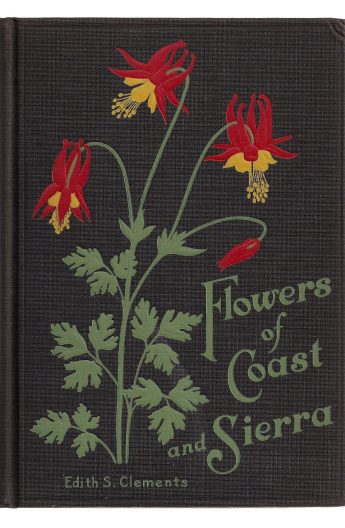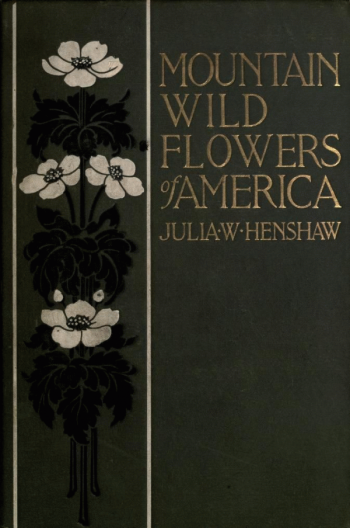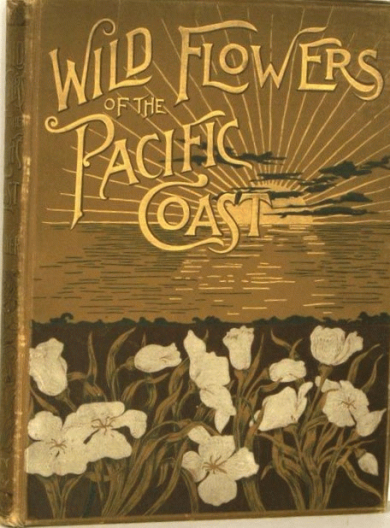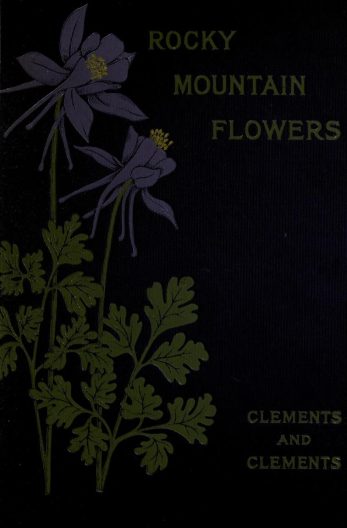 Unusual for her time, Edith Clements (1874-1971) had a formal botanical education; she received a Ph.D. in botanical ecology from the University of Nebraska, and spent her life in various academic and research pursuits. Typically this was in conjunction with her husband, Frederic Clements (1874-1945), who was also a plant ecologist. Together, they published “Rocky Mountain Flowers” in 1914, a botanically detailed flora of the flowering plants including trees, but no conifers or ferns. The watercolor illustrations by Edith Clements are exquisite, typically showing several plants from the same family together. On her own, she later published “Flowers of Mountain and Plain” (1926), a book for a more general audience using many of the same illustrations.
Unusual for her time, Edith Clements (1874-1971) had a formal botanical education; she received a Ph.D. in botanical ecology from the University of Nebraska, and spent her life in various academic and research pursuits. Typically this was in conjunction with her husband, Frederic Clements (1874-1945), who was also a plant ecologist. Together, they published “Rocky Mountain Flowers” in 1914, a botanically detailed flora of the flowering plants including trees, but no conifers or ferns. The watercolor illustrations by Edith Clements are exquisite, typically showing several plants from the same family together. On her own, she later published “Flowers of Mountain and Plain” (1926), a book for a more general audience using many of the same illustrations.
Excerpted from the Winter 2020 issue of the Arboretum Bulletin
 Unusual for her time, Edith Clements (1874-1971) had a formal botanical education; she received a Ph.D. in botanical ecology from the University of Nebraska, and spent her life in various academic and research pursuits. Typically this was in conjunction with her husband, Frederic Clements (1874-1945), who was also a plant ecologist. Together, they published “Rocky Mountain Flowers” in 1914, a botanically detailed flora of the flowering plants including trees, but no conifers or ferns. The watercolor illustrations by Edith Clements are exquisite, typically showing several plants from the same family together. On her own, she later published “Flowers of Mountain and Plain” (1926), a book for a more general audience using many of the same illustrations.
Unusual for her time, Edith Clements (1874-1971) had a formal botanical education; she received a Ph.D. in botanical ecology from the University of Nebraska, and spent her life in various academic and research pursuits. Typically this was in conjunction with her husband, Frederic Clements (1874-1945), who was also a plant ecologist. Together, they published “Rocky Mountain Flowers” in 1914, a botanically detailed flora of the flowering plants including trees, but no conifers or ferns. The watercolor illustrations by Edith Clements are exquisite, typically showing several plants from the same family together. On her own, she later published “Flowers of Mountain and Plain” (1926), a book for a more general audience using many of the same illustrations.
I think Edith saved her best work for West Coast readers, with “Flowers of Coast and Sierra” (1928), including the mountain ranges of Oregon and Washington, even if they are missing from the title. She was self-taught as an artist and comfortable driving throughout the West to paint from living specimens. While clearly steeped in botanical knowledge, she sought to reach a general audience with both her art and writing. An example is her impression of the glacier lily (Erythronium grandiflorum), saying these “will spring up by the thousand and carpet the earth with smooth green leaves which can scarcely be seen for the myriad bright-yellow blossoms nodding above. On the slopes of Mount Rainier, they unite with the white avalanche-lily (E. montanum) in turning the scene into fairyland.”
Excerpted from the Winter 2020 issue of the Arboretum Bulletin
“The Wild Flowers of California: Their Names, Haunts, and Habits” was the earliest (1897 – the Miller Library has the 1921 third edition) West Coast book published in a recognizably field guide format. Text author Mary Elizabeth Parsons (1859-1947) was born in Chicago, but spent most of her life in California. She was a keen student of the state’s botany and studied with noted botanist Alice Eastwood at the California Academy of Science in San Francisco.
Her book reflects her scientific discipline by including a “How to Use the Book” introduction, a glossary of botanical terms, and keys to distinguish plant families. She goes on to describe these families – all of flowering plants – with a count of the genera and species as known worldwide and in the state at that time. This makes the book a useful time capsule of botanical history.
Parsons also studied art, but she asked Margaret Warriner Buck (1857-1929) to illustrate the book and accompany her explorations of the state. With few exceptions, Buck drew her simple but effective pen-and-ink drawings in the field. All these efforts paid off, as the “The Wild Flowers of California” remained a standard through several editions into the middle of the 20th century. Later editions included color plates by Buck, also known for her work with the early years of “Sunset” magazine. The Miller Library also has the 1960 edition, available to borrow.
In addition to her attention to detail, Parsons captured the joy of being a field botanist. “Every walk into the fields is transformed from an aimless ramble into a joyous, eager quest, and every journey upon state or railroad becomes a rare opportunity for making new plant-acquaintances—a season of exhilarating excitement.”
Excerpted from the Winter 2020 issue of the Arboretum Bulletin

Margaret Armstrong was from the Hudson River valley of New York; she explored the West as part of an extended adventure, but never settled here. She traveled from 1911 to 1914, often with two or three female companions, exploring all of the states west of the Rocky Mountains and into Canada. She was possibly the first woman of European descent to travel to the floor of the Grand Canyon, where she found, described, and illustrated several new plant species. The result of these adventures was the “Field Book of Western Wild Flowers,” published in 1915.
She had considerable training as an artist and is perhaps best known amongst bibliophiles for the over 300 book covers she designed, an art form mostly lost in the 20th century with the development of dust jackets. She also wrote biographies in her 60s, and mystery novels in her 70s! Her schooling was in art, but she understood botany practices very well, collecting and pressing some 1,000 herbarium specimens. Many remain in the New York Botanical Garden herbarium. She lists as her co-author, John James Thornber (1872-1962), professor of botany at the University of Arizona, crediting him and many others (including Alice Eastwood and Julia Henshaw) for assuring the accuracy of her text.
“But it is her illustrations that make the book so appealing,” according to a review by Bobbi Angell in the December 2018 issue of “The Botanical Artist.” These included some 500 pen and ink drawings and almost 50 watercolors, all drawn or painted on site. While there is a glossary of terms and a short set of keys, this book relies more on its illustrations for identification than the others in this review.
Excerpted from the Winter 2020 issue of the Arboretum Bulletin
 Photography was a major innovation for field guides in the early 20th century. Julia W. Henshaw (1869-1937) was an early adopter with her 1906 book “Mountain Wild Flowers of America.” While this title implies inclusion of alpine plants across Canada and the United States, she lived in Vancouver, BC and gives special attention to our regional mountains. The Miller Library also has a later edition (1917) under the slightly revised title of “Wild Flowers of the North American Mountains.”
Photography was a major innovation for field guides in the early 20th century. Julia W. Henshaw (1869-1937) was an early adopter with her 1906 book “Mountain Wild Flowers of America.” While this title implies inclusion of alpine plants across Canada and the United States, she lived in Vancouver, BC and gives special attention to our regional mountains. The Miller Library also has a later edition (1917) under the slightly revised title of “Wild Flowers of the North American Mountains.”
Born in England, she studied art in her home country, but didn’t take up photography until she moved to British Columbia around 1890. Her images are in a studio setting, in grey scale with a neutral grey background. Ordered by color, it is not too difficult to imagine the appearance of the living plants.
Like other writers of these early field guides, Henshaw had abundant energy and a wide variety of interests. Daphne Bramham writes in the “Vancouver Sun” (published September 8, 2014) that she was “an explorer and general outdoorswoman” who climbed in the Rockies and mapped much of the interior of Vancouver Island. A strong advocate participation in World War I, she drove an ambulance at the Western Front in Europe, and spoke across Canada of her experience to encourage more involvement in the war effort. She had her indoor pursuits, too, as a theater critic (using Julian Durham as a pseudonym), writing novels, and founding a social club for women, the first such society in Vancouver.
Other than the use of photographs, this field guide is very similar in style to the others of the time. The writing is intended for a general audience, but Henshaw acknowledges a respectable list of botanists and naturalists as scientific advisors. However, she is at her best with her subjective descriptions. In reference to Erythronium giganteum (now E. grandiflorum var. grandiflorum), which in her day was burdened with the common name of “yellow adder’s tongue” (now “glacier lily”) she writes, “Late at evening, when beneath the star-sown purple of the sky you return from making some alpine ascent, the pure flames of these wild Lilies gleam in their leafy setting with a pale golden light, and illuminate the green brink of your path.”
Excerpted from the Winter 2020 issue of the Arboretum Bulletin
 “On the very top of the mound grew this fine salmon blossom, and a few feet away a bed of tall pink grass, the finest I had ever seen. It waved and nodded in the warm breeze, as if inviting me to select its finest bunch to keep company with the pretty white blossoms that had been its neighbors, and from whom it was loth to part company.”
“On the very top of the mound grew this fine salmon blossom, and a few feet away a bed of tall pink grass, the finest I had ever seen. It waved and nodded in the warm breeze, as if inviting me to select its finest bunch to keep company with the pretty white blossoms that had been its neighbors, and from whom it was loth to part company.”
Emma Homan Thayer (1842-1908) wrote these illustrative words, and painted these neighborly plants while visiting Astoria, Oregon in the 1880s. Her “Wild Flowers of the Pacific Coast” (published in 1887) is the earliest guide to the flora of the West Coast in the Miller Library collection. I hesitate to call it a field guide. Instead, it is a series of short travel essays, each tied to a local wild flower. Often the description of the people she encountered is more detailed than that of the flowers. The stories are mostly set in California, but she did make the one visit to Oregon, including a trip by boat from Portland to the mouth of the Columbia River.
In an appendix of “botanical descriptions,” the “fine salmon blossom” is identified as thimbleberry or Rubus nutkanus, but the identity of the grass is not attempted.
Born in New York, Thayer went back to school after her first husband died, attending Rutgers and area art institutions. Late in life, she established a reputation as an author of novels. However, it is for this book, and her similar book, “Wild Flowers of the Rocky Mountains,” that she is best known. While her impressionistic style of illustration lacks the fine detail necessary for certain identification, her books were an introduction, especially for East Coast audiences, to the splendors of the western flora.
Excerpted from the Winter 2020 issue of the Arboretum Bulletin
 Unusual for her time, Edith Clements (1874-1971) had a formal botanical education; she received a Ph.D. in botanical ecology from the University of Nebraska, and spent her life in various academic and research pursuits. Typically this was in conjunction with her husband, Frederic Clements (1874-1945), who was also a plant ecologist. Together, they published “Rocky Mountain Flowers” in 1914, a botanically detailed flora of the flowering plants including trees, but no conifers or ferns. This is not a field guide, but the watercolor illustrations by Edith Clements are exquisite, typically showing several plants from the same family together. On her own, she later published “Flowers of Mountain and Plain” (1926), a book for a more general audience using many of the same illustrations.
Unusual for her time, Edith Clements (1874-1971) had a formal botanical education; she received a Ph.D. in botanical ecology from the University of Nebraska, and spent her life in various academic and research pursuits. Typically this was in conjunction with her husband, Frederic Clements (1874-1945), who was also a plant ecologist. Together, they published “Rocky Mountain Flowers” in 1914, a botanically detailed flora of the flowering plants including trees, but no conifers or ferns. This is not a field guide, but the watercolor illustrations by Edith Clements are exquisite, typically showing several plants from the same family together. On her own, she later published “Flowers of Mountain and Plain” (1926), a book for a more general audience using many of the same illustrations.
Willa Cather was a classmate of Frederic and a good friend of Edith and it’s likely their scientific knowledge influenced the environmental aspects of the novelist’s writing. In an interview by Eleanor Hinman in the “Lincoln Sunday Star (November 6, 1921), Cather expressed her love of Nebraska wild flowers, concluding, “There is one book that I would rather have produced than all my novels. That is the Clements botany dealing with the wild flowers of the west.”
Excerpted from the Winter 2020 issue of the Arboretum Bulletin
 It was on a visit to the United States that Alice Lounsberry (1873-1949) of Boston, some 25 years younger, introduced herself to Australian painter Ellis Rowan. Lounsberry convinced Rowan to travel with her for two years, providing illustrations for three books she wrote on native plants: “A Guide to the Wild Flowers” (1899), “A Guide to Trees” (1900), and “Southern Wild Flowers and Trees” (1901).
It was on a visit to the United States that Alice Lounsberry (1873-1949) of Boston, some 25 years younger, introduced herself to Australian painter Ellis Rowan. Lounsberry convinced Rowan to travel with her for two years, providing illustrations for three books she wrote on native plants: “A Guide to the Wild Flowers” (1899), “A Guide to Trees” (1900), and “Southern Wild Flowers and Trees” (1901).
At the turn of the 20th century, it was an adventure, especially for two women, to be exploring the rural parts of the southeast. In “Southern Wild Flower and Trees,” Lounsberry writes “Mrs. Rowan and I travelled in many parts of the south, exercising always our best blandishments to get the people of the section to talk with us. Through the mountainous region we drove from cabin to cabin, and nowhere could we have met with greater kindness and hospitality.” The illustrations include plates in color, many black and white diagrams, and some delightful vignettes, typically showing native plants in the context of a larger landscape.
They were a good team. Lounsberry provided detailed botanic structure along with engaging observations of her subjects and their natural history, while Rowan’s artwork found a new audience. Together, their books were very popular.
Excerpted from the Winter 2019 Arboretum Bulletin
The Lady Bird Johnson Wildflower Center site offers a database with information on native plants and related organizations searchable by region, state or city. Included are native plant societies, conservation groups, governmental agencies, botanic gardens and arboreta. Sources for nurseries and seed suppliers are searchable by an alphabetical list, or by state, city, or zip. The “Mr. Smarty Plants” database has questions answered by staff members of the Wildflower Center.
Ready to trade in that thirsty boring lawn for a wildflower meadow? Do a bit of research first with British gardener Christopher Lloyd’s book called Meadows (Timber Press, $29.95). Lloyd dispels the myth of a maintenance-free meadow without dampening the reader’s enthusiasm for creating a flowery, drought-tolerant lawn alternative.
Additional wildflower information is available online:
 Unusual for her time, Edith Clements (1874-1971) had a formal botanical education; she received a Ph.D. in botanical ecology from the University of Nebraska, and spent her life in various academic and research pursuits. Typically this was in conjunction with her husband, Frederic Clements (1874-1945), who was also a plant ecologist. Together, they published “Rocky Mountain Flowers” in 1914, a botanically detailed flora of the flowering plants including trees, but no conifers or ferns. The watercolor illustrations by Edith Clements are exquisite, typically showing several plants from the same family together. On her own, she later published “Flowers of Mountain and Plain” (1926), a book for a more general audience using many of the same illustrations.
Unusual for her time, Edith Clements (1874-1971) had a formal botanical education; she received a Ph.D. in botanical ecology from the University of Nebraska, and spent her life in various academic and research pursuits. Typically this was in conjunction with her husband, Frederic Clements (1874-1945), who was also a plant ecologist. Together, they published “Rocky Mountain Flowers” in 1914, a botanically detailed flora of the flowering plants including trees, but no conifers or ferns. The watercolor illustrations by Edith Clements are exquisite, typically showing several plants from the same family together. On her own, she later published “Flowers of Mountain and Plain” (1926), a book for a more general audience using many of the same illustrations. Unusual for her time, Edith Clements (1874-1971) had a formal botanical education; she received a Ph.D. in botanical ecology from the University of Nebraska, and spent her life in various academic and research pursuits. Typically this was in conjunction with her husband, Frederic Clements (1874-1945), who was also a plant ecologist. Together, they published “
Unusual for her time, Edith Clements (1874-1971) had a formal botanical education; she received a Ph.D. in botanical ecology from the University of Nebraska, and spent her life in various academic and research pursuits. Typically this was in conjunction with her husband, Frederic Clements (1874-1945), who was also a plant ecologist. Together, they published “
 Photography was a major innovation for field guides in the early 20th century. Julia W. Henshaw (1869-1937) was an early adopter with her 1906 book “Mountain Wild Flowers of America.” While this title implies inclusion of alpine plants across Canada and the United States, she lived in Vancouver, BC and gives special attention to our regional mountains. The Miller Library also has a later edition (1917) under the slightly revised title of “
Photography was a major innovation for field guides in the early 20th century. Julia W. Henshaw (1869-1937) was an early adopter with her 1906 book “Mountain Wild Flowers of America.” While this title implies inclusion of alpine plants across Canada and the United States, she lived in Vancouver, BC and gives special attention to our regional mountains. The Miller Library also has a later edition (1917) under the slightly revised title of “ “On the very top of the mound grew this fine salmon blossom, and a few feet away a bed of tall pink grass, the finest I had ever seen. It waved and nodded in the warm breeze, as if inviting me to select its finest bunch to keep company with the pretty white blossoms that had been its neighbors, and from whom it was loth to part company.”
“On the very top of the mound grew this fine salmon blossom, and a few feet away a bed of tall pink grass, the finest I had ever seen. It waved and nodded in the warm breeze, as if inviting me to select its finest bunch to keep company with the pretty white blossoms that had been its neighbors, and from whom it was loth to part company.” Unusual for her time, Edith Clements (1874-1971) had a formal botanical education; she received a Ph.D. in botanical ecology from the University of Nebraska, and spent her life in various academic and research pursuits. Typically this was in conjunction with her husband, Frederic Clements (1874-1945), who was also a plant ecologist. Together, they published “Rocky Mountain Flowers” in 1914, a botanically detailed flora of the flowering plants including trees, but no conifers or ferns. This is not a field guide, but the watercolor illustrations by Edith Clements are exquisite, typically showing several plants from the same family together. On her own, she later published “
Unusual for her time, Edith Clements (1874-1971) had a formal botanical education; she received a Ph.D. in botanical ecology from the University of Nebraska, and spent her life in various academic and research pursuits. Typically this was in conjunction with her husband, Frederic Clements (1874-1945), who was also a plant ecologist. Together, they published “Rocky Mountain Flowers” in 1914, a botanically detailed flora of the flowering plants including trees, but no conifers or ferns. This is not a field guide, but the watercolor illustrations by Edith Clements are exquisite, typically showing several plants from the same family together. On her own, she later published “ It was on a visit to the United States that Alice Lounsberry (1873-1949) of Boston, some 25 years younger, introduced herself to Australian painter Ellis Rowan. Lounsberry convinced Rowan to travel with her for two years, providing illustrations for three books she wrote on native plants: “
It was on a visit to the United States that Alice Lounsberry (1873-1949) of Boston, some 25 years younger, introduced herself to Australian painter Ellis Rowan. Lounsberry convinced Rowan to travel with her for two years, providing illustrations for three books she wrote on native plants: “